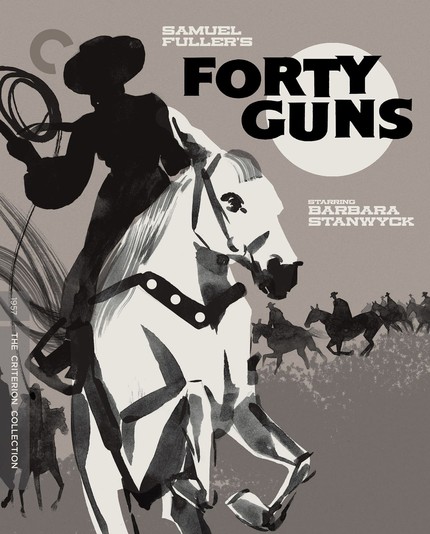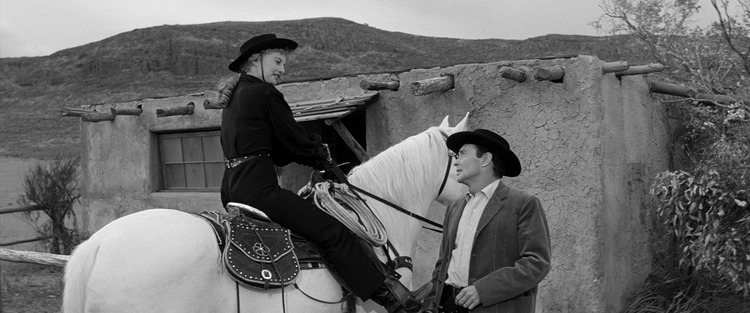Blu-ray Review: FORTY GUNS Rides Out on Criterion
Barbara Stanwyck leads the charge in Samuel Fuller's blazing Western yarn.

Don’t be surprised to come away from Samuel Fuller’s Forty Guns a bit dizzy. And know that with that advice in tow, it may be the only time you aren’t surprised during this senses-shattering 1957 Western.
Boldly shot in both CinemaScope and cool black and white, Forty Guns marks the waning period of the Hollywood Western revival heyday with a swift pistol whipping on the cloven heels of a forty-one horse tear across the dusty plains and the film’s few opening titles. The unsuspecting fellas on the wagon they blast passed, suddenly and mercilessly engulfed in dust clouds fifteen feet high, never know what nearly hit them. And just as suddenly as they descended from around the bend, they’re gone around another. Led by a spitfire gal in all black, the wagon master’s unspoken response says it all. Who in tarnation was that?!?
It’s both our question and the question of Griff Bonell, (Barry Sullivan) the local lawman who also happened to be driving the aforementioned wagon. As one of the film’s two songs tells us, the leader is none other than the local high ridin’ woman with a whip. Meet the unmistakable feminist key to Forty Guns, Jessica Drummond, wealthy land baroness, the true boss of nearby Cochise County, and no slouch in the saddle herself.
Her primary line of enforcement? Forty of the most dangerous hired guns to be found. She is their employer, not their partner- a fact that she makes sure they understand. With her troublemaking younger brother, Brockie (John Ericson) under her thumb, there’s no question that this is a woman in charge.
For audiences, both then and now, the shorter answer to the identity of the black-clad lead rider is none other than Barbara Stanwyck. One of the great enduring stars of Hollywood’s Golden Age, Forty Guns finds Stanwyck, age fifty, at what would prove to be her big screen swan song as a leading lady. This famously brassy gal would have decades of career ahead of her, but it’s this film in which she is afforded the chance to showcase all of her skills and attributes. Self-assured, rugged, direct and in control, her character is nevertheless also layered, nuanced, sexy, enigmatic, and finally, vulnerable.
Never mind that that final attribute can’t help but undercut all the rest- chalk it up to a studio mandated “softer ending” than writer/director Fuller claims to have ever intended. This is Stanwyck in all her glory- not just doing all her own riding, but all of her own stunts. One need only experience the actress being dragged on the ground, one foot caught in a stirrup, during a fabricated violent dust tornado, to have one’s existing notion of Stanwyck forever elevated.
It’s safe to speculate that no other longstanding A-list talents of any gender would be game for such a shot, particularly not the storied three takes that Fuller got out of her, chucking dirt, tumbleweeds and debris all the while as her head bobs across the desert floor, inches from incensed galloping horse hooves. There’s a reason that Sam Fuller absolutely loved Stanwick, calling her “a helluva lady” in his indispensable posthumous biography, A Third Face, a book that every film buff should reward themselves by reading.
Campy double entendres crackle throughout, writerly to the core, and all classically Fuller. It’s a two-way race for best exchange in Forty Guns, the first being the aftermath of a first kiss between a female gunsmith and her new beau. “Any recoil?,” she coyly asks. The other, between Jessica and Griff, climaxes as she’s asking to see his gun. “It might go off in your face,” he warns. “I'll take a chance,”she replies. And she takes the chance, indeed.
The characters make hard-bitten pronouncements, observations gleaned through their palpable years of experience. Griff, desperate to preserve his younger brother’s innocence in terms of having never taken human life, tells him, “In my heart I've always asked forgiveness before I kill, just like an Indian asking for forgiveness from an animal before the slaughter. You can't ask after you kill- it's too late then.” The arc of this relationship might be the true tragedy of the piece.
Fuller’s dialogue, like the stories they’re masterfully woven into, isn’t intended to be “historical”. It is, however, rooted firmly in emotional truth- real truths, independent to each picture. Fuller didn’t care to recreate reality; he was in the business of spinning what he referred to as “yarns”. And he spun ‘em hard and memorable, wherever he went.
It’s particularly notable that Guns came about at the start of Globe Productions, Fuller’s own production company, while still maintaining his relationship with Darryl Zanuck and Twentieth Century Fox, if moving them to arm’s length, in a distribution role. That said, the aforementioned softened ending has every indication of good old studio meddling regarding Fox not wanting the incredibly dark and cold ending that Fuller imagined. Fuller proved to be enough of a team player to make the change, even as the rest of the film pops for the myriad of his and only his vivaciously personal originality and defiant spark.
Criterion really delivers the goods with this surprise year-ending release. More Sam Fuller, treated right, is always welcome. When it’s one of his standout titles from his 1950s directorial heyday, such is the case with Forty Guns, it advances from “always welcome” to cinematically essential. The picture simply looks beautiful.
“The Fuller Women” is a tremendously fun Criterion special feature in which the director’s widow, Christa Lang Fuller, and his daughter, Samantha Fuller, go through a box of his old keepsakes from Forty Guns. With that as their springboard, their great humor and honest fondness and recollection of the man shines brightly. They’re quick to rightly point out how influential Forty Guns has been to Jean-Luc Godard, Sergio Leone, and James Bond. (Check out that gun barrel shot, a more directly phallic visual gag than 007 ever pulled off, despite that franchise’s fifty-plus-year history of such good humored attempts.
Drier but nevertheless another fine feature is a nearly thirty-minute interview, by film historian Imogen Sara Smith. A really stupendous addition is A Fuller Life, Samantha Fuller’s 2013 feature length documentary about her father, which is narrated, completely in his words, by actors and co-workers from throughout his filmmaking career. The man himself is heard in a 1969 Q&A session which can be heard on an optional audio track that runs the duration of Forty Guns. It’s pretty priceless, as everyone needs to experience Sam Fuller telling his long-winded tales. It’s hard not to come away talking just little bit like him…
So let’s get one thing straight: The 1950’s Western is a special thing. It’s a special niche- a big one!- in an already important genre. The genre by that point has already ebbed and flowed and peaked and pranced in various incarnations, for decades. By the time of Forty Guns, the innovative storytellers of the time were perfecting what we’ve come to call “the psychological Western.”
Directors like Anthony Mann and Sam Fuller were seriously hitting the gas of their careers with their psychological Westerns; long established directors like John Ford (The Searchers) and William Wellman (Track of the Cat) we’re ramping up to some of their best stuff. Budd Boetticher (The Tall T, Ride Lonesome) and even actor Ray Milland (A Man Alone, a fantastic little film new to Blu-ray from Kino Lorber) were scrapping along in Poverty Row, pushing the Western, and by extension, the future of popular cinema, into new depths on a shoestring.
Somewhere in the audience, Sam Peckinpah and Sergio Leone were perking up, paying close attention. This was the greatest time of the Western, a vital moment in the development of America’s key film genre, and simply some of the most rip-roaring, engaging movie entertainment ever unleashed. Fuller, with Forty Guns, is no less on the forefront than anyone. In fact, he just might’ve been leading the charge.








